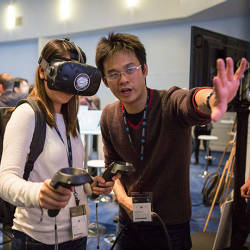
Company recruiters looking to turn heads at today's hyper-competitive job fairs are finding that virtual reality (VR) has just the right gee-whiz factor.
Our "VRTEX units usually quickly attract a crowd" at job fairs, says Gary Coleman, group leader, marketing communications at Lincoln Electric, a maker of welding products and of VR experiences that simulate what it's like to be a welder.
Coleman says Lincoln's VRTEX welding training simulators, which enable job candidates to don a VR helmet and try their hand at fusing steel with fire in a virtual environment, are a natural for young job applicants, most of whom were raised on videogaming. Such trade show attendees are "are very familiar with gaming environments and very interested in VR immersive experiences," he says.
The real bang for the buck, though, comes from the giant video monitors that companies generally use at job fairs along with VRTEX, which broadcast the immersive welding experience to passersby, Coleman says. "These large monitors allow a small crowd to see the actual real-time performance of any person welding at the simulator."
For recruiters in search of white-collar employees, immersive VR is often used at job fairs to give candidates a feel for a firm's corporate culture, or a quick sample of the key personalities they'll be working with, says Dave Beck, founder of Atlanta, GA-based Foundry 45, a VR marketing agency. "VR is an amazing way for companies to break through the noise and get people to listen to their message, whether it be by engaging with their people, seeing their office environment in person, or 'virtually' becoming a part of their culture and brand for a brief moment," Beck says.
"The most basic reason brands typically come to us is because they want to generate excitement and buzz for what they are doing," Beck says. "They want to connect with their prospects by showing them the emotional side of their people, brand, products, or services, and what a typical day at their company is like."
Adds Andrew Woodbury, head of sales and marketing at InstaVR, a San Francisco-based maker of VR authoring software, "I like 'Day in the Life' VR applications that simulate job functions. These are good for helping candidates determine if they'd like doing something on a daily basis or not."
Many users also get extra mileage from their VR experiences by posting them in the careers domain of company websites.
"Linear VR experiences are perfect for this application because candidates can easily download the application and jump into the customer's virtual world," Beck says. "Companies can also post 360-degree video versions that can be streamed on YouTube 360 or Facebook 360."
Woodbury agrees. "WebVR has value even if a user doesn't have a headset. We have an auto-rotate feature that allows you to embed the VR, and have that scene rotate in 360 degrees on the page. It's very eye-catching, and then users can interact by clicking on their laptop." Some clients, he says, "will use WebVR as basically an ad to get users to download their iOS, Android, Gear VR, Oculus Go, etc., app."
Surprisingly, the cost to create an immersive VR experience can be less that what Human Resources typically pays for a standard recruiting video or app.
"You can do it all in-house, without contracting out to an agency," says Woodbury. "There's plenty of user-friendly, high-resolution, affordable 360-degree cameras, and new standalone mobile headsets like the Oculus Go at $200 give a great user-experience."
Using VR software is relatively painless, Woodbury says. "Creating the applications can be done by HR people using a platform like InstaVR, which requires no coding or prior experience, in a matter of days, or even hours if they're really motivated."
Plus, given that 'shorter is generally better' when it comes to VR productions, HR departments will find they need only an experience that runs a few minutes to create a draw at a job fairs. "Shorter VR is always better," Woodbury says. "VR headsets are still somewhat cumbersome, and it's straining on the eyes to have a wide 'field of view' full of action for too long. Five to 10 minutes, or even less, is still the sweet spot."
Says Beck, "We actually recommend that businesses create experiences in the two- to three-minute range. If they want to cover a broad variety of topics, then we suggest creating multiple, separate videos."
For job fairs, Woodbury recommends using a mix of VR headsets. "I like a combination of one or more high-end VR headsets—Oculus Go, Gear VR, Oculus Rift, HTC Vive, etc.—with a few lower-end headsets; i.e., Google Cardboard. That way, when there's lots of traffic, you don't miss out on people trying your app. But for serious candidates, you definitely want something more immersive than a (Google) Cardboard."
The surge in business use of VR is a welcome boost for VR hardware and software makers, who are still looking for the much hoped-for consumer craze over the tech to kick in.
Most recently, for example, VR training and learning company STRIVR cut a deal with Walmart to place four Oculus Go headsets in every Walmart Supercenter, and two headsets in every Walmart Neighborhood Market and discount store. By the close of 2018, STRIVR plans to place 17,000 Oculus Go headsets throughout the Walmart chain, which will be used for employee training.
Says Tom Haak, director of the Netherlands-based HR Trend Institute, "Today it is all about improving the candidate and employee experience, and virtual reality/augmented reality solutions can help in many areas to improve the experience."
Joe Dysart is an Internet speaker and business consultant based in Manhattan, NY, USA.



Join the Discussion (0)
Become a Member or Sign In to Post a Comment